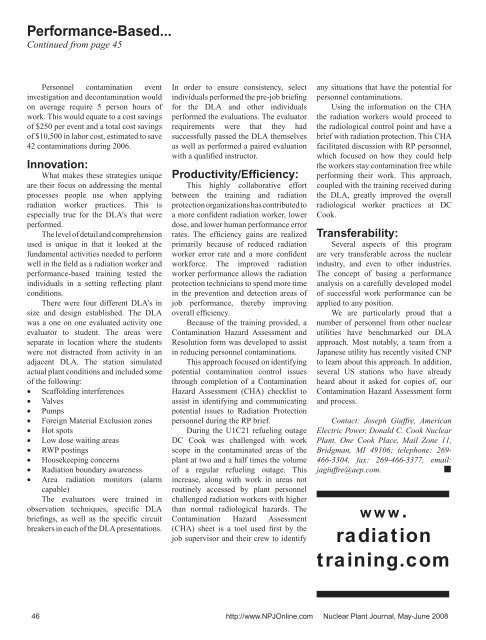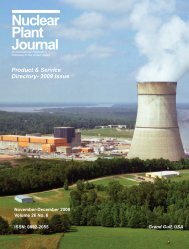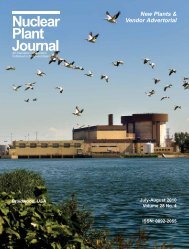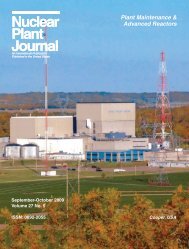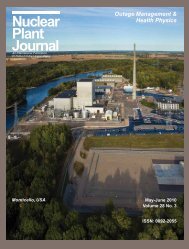Nuclear Plant Journal, May-June 2008
Nuclear Plant Journal, May-June 2008
Nuclear Plant Journal, May-June 2008
Create successful ePaper yourself
Turn your PDF publications into a flip-book with our unique Google optimized e-Paper software.
Performance-Based...<br />
Continued from page 45<br />
Personnel contamination event<br />
investigation and decontamination would<br />
on average require 5 person hours of<br />
work. This would equate to a cost savings<br />
of $250 per event and a total cost savings<br />
of $10,500 in labor cost, estimated to save<br />
42 contaminations during 2006.<br />
Innovation:<br />
What makes these strategies unique<br />
are their focus on addressing the mental<br />
processes people use when applying<br />
radiation worker practices. This is<br />
especially true for the DLA’s that were<br />
performed.<br />
The level of detail and comprehension<br />
used is unique in that it looked at the<br />
fundamental activities needed to perform<br />
well in the field as a radiation worker and<br />
performance-based training tested the<br />
individuals in a setting reflecting plant<br />
conditions.<br />
There were four different DLA’s in<br />
size and design established. The DLA<br />
was a one on one evaluated activity one<br />
evaluator to student. The areas were<br />
separate in location where the students<br />
were not distracted from activity in an<br />
adjacent DLA. The station simulated<br />
actual plant conditions and included some<br />
of the following:<br />
• Scaffolding interferences<br />
• Valves<br />
• Pumps<br />
• Foreign Material Exclusion zones<br />
• Hot spots<br />
• Low dose waiting areas<br />
• RWP postings<br />
• Housekeeping concerns<br />
• Radiation boundary awareness<br />
• Area radiation monitors (alarm<br />
capable)<br />
The evaluators were trained in<br />
observation techniques, specific DLA<br />
briefings, as well as the specific circuit<br />
breakers in each of the DLA presentations.<br />
In order to ensure consistency, select<br />
individuals performed the pre-job briefing<br />
for the DLA and other individuals<br />
performed the evaluations. The evaluator<br />
requirements were that they had<br />
successfully passed the DLA themselves<br />
as well as performed a paired evaluation<br />
with a qualified instructor.<br />
Productivity/Efficiency:<br />
This highly collaborative effort<br />
between the training and radiation<br />
protection organizations has contributed to<br />
a more confident radiation worker, lower<br />
dose, and lower human performance error<br />
rates. The efficiency gains are realized<br />
primarily because of reduced radiation<br />
worker error rate and a more confident<br />
workforce. The improved radiation<br />
worker performance allows the radiation<br />
protection technicians to spend more time<br />
in the prevention and detection areas of<br />
job performance, thereby improving<br />
overall efficiency.<br />
Because of the training provided, a<br />
Contamination Hazard Assessment and<br />
Resolution form was developed to assist<br />
in reducing personnel contaminations.<br />
This approach focused on identifying<br />
potential contamination control issues<br />
through completion of a Contamination<br />
Hazard Assessment (CHA) checklist to<br />
assist in identifying and communicating<br />
potential issues to Radiation Protection<br />
personnel during the RP brief.<br />
During the U1C21 refueling outage<br />
DC Cook was challenged with work<br />
scope in the contaminated areas of the<br />
plant at two and a half times the volume<br />
of a regular refueling outage. This<br />
increase, along with work in areas not<br />
routinely accessed by plant personnel<br />
challenged radiation workers with higher<br />
than normal radiological hazards. The<br />
Contamination Hazard Assessment<br />
(CHA) sheet is a tool used first by the<br />
job supervisor and their crew to identify<br />
any situations that have the potential for<br />
personnel contaminations.<br />
Using the information on the CHA<br />
the radiation workers would proceed to<br />
the radiological control point and have a<br />
brief with radiation protection. This CHA<br />
facilitated discussion with RP personnel,<br />
which focused on how they could help<br />
the workers stay contamination free while<br />
performing their work. This approach,<br />
coupled with the training received during<br />
the DLA, greatly improved the overall<br />
radiological worker practices at DC<br />
Cook.<br />
Transferability:<br />
Several aspects of this program<br />
are very transferable across the nuclear<br />
industry, and even to other industries.<br />
The concept of basing a performance<br />
analysis on a carefully developed model<br />
of successful work performance can be<br />
applied to any position.<br />
We are particularly proud that a<br />
number of personnel from other nuclear<br />
utilities have benchmarked our DLA<br />
approach. Most notably, a team from a<br />
Japanese utility has recently visited CNP<br />
to learn about this approach. In addition,<br />
several US stations who have already<br />
heard about it asked for copies of, our<br />
Contamination Hazard Assessment form<br />
and process.<br />
Contact: Joseph Giuffre, American<br />
Electric Power, Donald C. Cook <strong>Nuclear</strong><br />
<strong>Plant</strong>, One Cook Place, Mail Zone 11,<br />
Bridgman, MI 49106; telephone: 269-<br />
466-3304, fax: 269-466-3377, email:<br />
jagiuffre@aep.com.<br />
<br />
www.<br />
radiation<br />
training.com<br />
46 http://www.NPJOnline.com <strong>Nuclear</strong> <strong>Plant</strong> <strong>Journal</strong>, <strong>May</strong>-<strong>June</strong> <strong>2008</strong>


